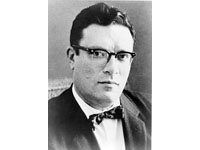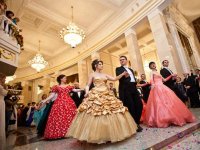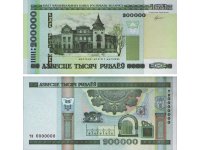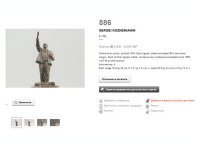Marc Chagall
Author: Lida added 17-09-2012, 23:42
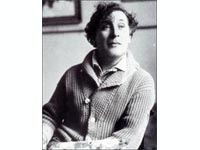
Marc Chagall was an artist associated with several major artistic styles and one of the most successful artists of the 20th century. He was an early modernist, and created works in virtually every artistic medium, including painting, book illustrations, stained glass, stage sets, ceramic, tapestries and fine art prints.
Marc Chagall, born Moishe Shagal, was born in Liozna, near the city of Vitebsk (Belarus, then part of the Russian Empire) in 1887.
In Russia at that time, Jewish children were not allowed to attend regular Russian schools or universities. Their movement within the city was also restricted. Chagall therefore received his primary education at the local Jewish religious school. From 1900 to 1905 Chagall studied at Vitebsk four-year College. In 1906, he studied fine art at School of Art in Vitebsk with artist M. Pan, then moved to St. Petersburg. By 1907, he had begun painting naturalistic self-portraits and landscapes.
Between 1908 to 1910, Chagall was in St. Petersburg, where he was a student of Léon Bakst at the Zvantseva School of Drawing and Painting. He stayed there until 1910, often visiting Vitebsk where he met Bella Rosenfeld.
In 1910, Chagall, moved to Paris for four years. It was during this period that he painted some of his most famous paintings of the Jewish village, and developed the features that became recognizable trademarks of his art.
Because he missed his fiancée, Bella, who was still in Vitebsk and was afraid of losing her, Chagall decided to accept an invitation from a noted art dealer in Berlin to exhibit his work, his intention being to continue on to Belarus, marry Bella, and then return with her to Paris. After the exhibit, he continued on to Vitebsk, where he planned to stay only long enough to marry Bella. However, after a few weeks, the First World War began, closing the Russian border for an indefinite period. A year later he married Bella Rosenfeld and they had their first child, Ida.
The October Revolution of 1917 was a dangerous time for Chagall although it also offered opportunity. By then he was one of the Russia's most distinguished artists and a member of the modernist avant-garde. He was offered a notable position as a commissar of visual arts for the country, but preferred something less political, and instead accepted a job as commissar of arts for Vitebsk. This resulted in his founding the Vitebsk Arts College which, adds Lewis, became the "most distinguished school of art in the Soviet Union".
In 1915, Chagall began exhibiting his work in Moscow, first exhibiting his works at a well-known salon and in 1916 exhibiting pictures in St. Petersburg. He again showed his art at a Moscow exhibition of avant-garde artists. This exposure brought recognition, and a number of wealthy collectors began buying his art. He also began illustrating a number of Yiddish books with ink drawings. Chagall was 30 years old and had begun to become well known.
In 1923, Chagall left Moscow to return to France. On his way he stopped in Berlin to recover the many pictures he had left there on exhibit ten years earlier.
By 1926 he had his first exhibition in the United States at the Reinhardt gallery of New York which included about 100 works, although he did not travel to the opening. Instead he stayed in France to paint.
In addition to images of the Jewish world, Chagall's paintings are inspired by themes from the Bible. His fascination with the Bible culminated in a series of over 100 etchings illustrating the Bible, many of which incorporate elements from folklore and from religious life in Russia.
Israel, which Chagall first visited in 1931 for the opening of the Tel Aviv Art Museum, is likewise endowed with some of Chagall's work, most notably the twelve stained glass windows at Hadassah Hospital and wall decorations at the Knesset.
When the II World War began, Chagall have learned that Jews were being removed from public and academic positions, and The only refuge could be America.
Even before arriving in America in 1941, Chagall was awarded the Carnegie Prize in 1939. After being in America he discovered that he had already achieved "international stature, although he felt ill-suited in this new role in a foreign country whose language he could not yet speak. He became a celebrity mostly against his will, feeling lost in the strange surroundings.
When Chagall returned to New York in 1943, however, current events began to interest him more, and this was represented by his art, where he painted subjects including the Crucifixion and scenes of war. He learned that the Germans had destroyed the town where he was raised, Vitebsk, and became greatly distressed.
In 1944, Bella died suddenly due to a virus infection, which was not treated due to the wartime shortage of medicine. As a result, he stopped all work for many months, and when he did resume painting his first pictures were concerned with preserving Bella's memory.
After a year of living with his daughter, Ida, and her husband Michel Gordey, he entered into a romance with Virginia Haggard, great-niece of the author Henry Rider Haggard; their relationship endured seven years. They had a child together.
By 1946, his artwork was becoming more widely recognized. The Museum of Modern Art in New York had a large exhibition representing 40 years of his work which gave visitors one of the first complete impressions of the changing nature of his art over the years.
After returning to France he traveled throughout Europe and chose to live in the Côte d'Azur which by that time had become somewhat of an "artistic centre".
Chagall died at the age of ninety-seven in 1985. He received many prizes and much recognition for his work. He was also one of very few artists to exhibit work at the Louvre in their lifetime.
Donate:







